16 Native Plants That Will Transform Your Missouri Yard
BY FARAH NAUMAN | MAY 24TH, 2023 | LAWN CARE, MISSOURIGardening can be a drag when you struggle to keep your plants alive and vibrant, but you can enjoy a fantastic garden with one simple trick: Go with native plants that are adapted to our warm summers and cold, snowy winters. Need a guide? Here are 16 native plants that will transform your Missouri yard.
In this article:
- Black-eyed Susan
- Cardinal Flower
- Blue Vervain
- White Beardtongue
- Pawpaw
- Wild Hydrangea
- Flowering Dogwood
- Blazing Star
- Spicebush
- Purple Coneflower
- Blue Lobelia
- Swamp Milkweed
- Butterfly Milkweed
- Pink Turtlehead
- Red Buckeye
- Prairie Dropseed
What Is a Native Plant?
Native plants are indigenous to an area, so they have adapted to a certain set of environmental conditions, including a region’s climate, soil, temperature, and light conditions. This happens over the course of hundreds or thousands of years.
Missouri native plants grow naturally in our climate and geology and amid our wildlife. In fact, many wildlife species depend on native plants for habitat and survival. They essentially become a part of the region’s ecosystem.
Why Consider Native Plants?
Planting natives isn’t just easy, it’s also beneficial to your environment. Take a look at a few advantages of native plants:
- They are very low-maintenance because they have evolved in the very soil conditions, soil pH, light, temperature, and moisture of Missouri’s climate.
- Native plants preserve natural diversity and resist invasive non-natives that may threaten wildlife and crops in Missouri.
- They attract beneficial birds, pollinators, and other wildlife to your garden.
- Natives are stronger and tougher, which translates into lesser diseases, fewer pesticides, and low fertilizer needs.
- These plants make the environment safer since they need fewer fertilizers and pesticides, and resultantly, reduce the chemical pollution and damage to the ecosystem.
- Natives help preserve water since they need far less supplemental watering. They are naturally adept to the climate and save tons of resources, money, and time.
- There is a wide variety of native plants for Missouri that you can choose from.
Great Native Plants for Your Missouri Yard
Here is a collection of Missouri’s best natives that will give you a low-maintenance landscape.
1. Black-eyed Susan (Rudbeckia hirta)
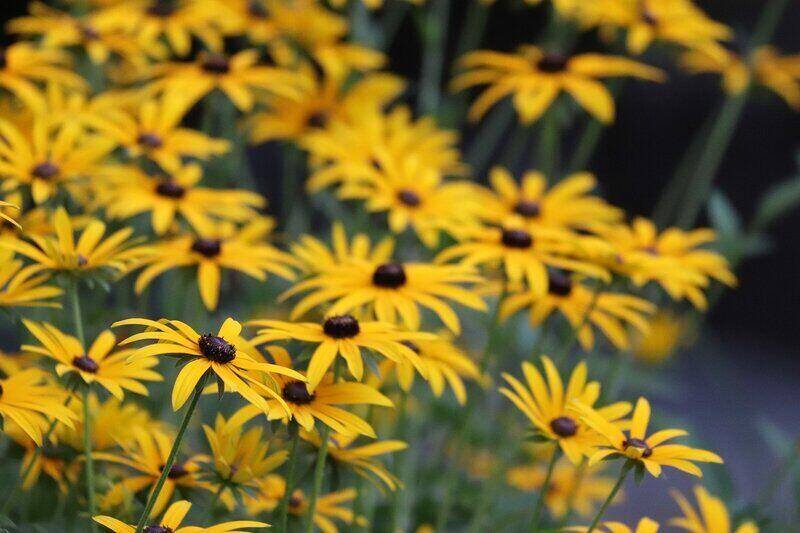
Photo Credit: Pixabay
The showy black-eyed Susan plant is known for its yellow to orange-yellow rays and dark brown centers that attract butterflies. It is typically found in fields, prairies, open woods, waste areas, and roadsides throughout the state.
The black-eyed Susan is a hairy, coarse, and somewhat weedy plant. And that might bother you, but the freshness of daisy-like flowers and chocolate brown disks atop a stiff, upright, leafy stem will make up for it. Black-eyed Susans are tough, too. They resist deer, insects, and diseases. They also self-seed and are perfect for mass plantings, cottage gardens, annual beds, wild gardens, and meadows.
This native plant naturally attracts butterflies and bees, prefers dry soil, and is easy to maintain as well. It does well both in the ground and in containers.
Plant type: Herbaceous perennial
Mature size: 2 to 3 feet tall
Duration: Annual (can be perennial or biennial)
Bloom time: June to September
Sunlight needs: Full sun
Soil preferences: Loam or sandy soil
Water needs: Medium
Maintenance needs: Low
USDA hardiness zone: 3 to 7
2. Cardinal Flower (Lobelia Cardinalis)
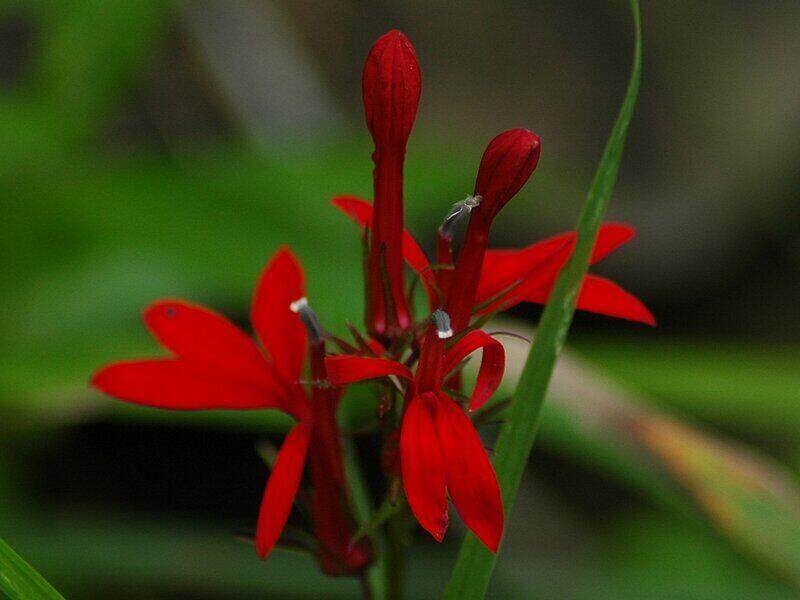
Photo Credit: linnaeus / Wikimedia Commons / CC BY 3.0
This native plant produces large, distinctive, bright red petals and has a spiky, upright appearance that makes it stand out in a landscape. The cardinal flower, which takes its name from the red robes worn by Roman Catholic cardinals, can grow as tall as 6 feet and grows naturally along stream banks, and in swamps and moist places.
That doesn’t mean you have to live in a swamp to enjoy it. The cardinal flower grows well in average soil conditions and does well in both full sun and partial shade. The upright stems and bright flowers attract lots of winged visitors and are a popular source of nectar for hummingbirds.
This is one of the most low-maintenance native plants you can get because it wards off pests and disease really well. In ideal growing conditions, it may self-seed.
Plant type: Flower, herbaceous
Mature size: 1 to 6 feet tall
Duration: Perennial
Bloom time: July to September
Sunlight needs: Full sun, partial shade, or full shade
Soil preferences: Loam, sand, clay
Water needs: High
Maintenance needs: Low
USDA hardiness zone: 3 to 9
3. Blue Vervain (Verbena hastata)
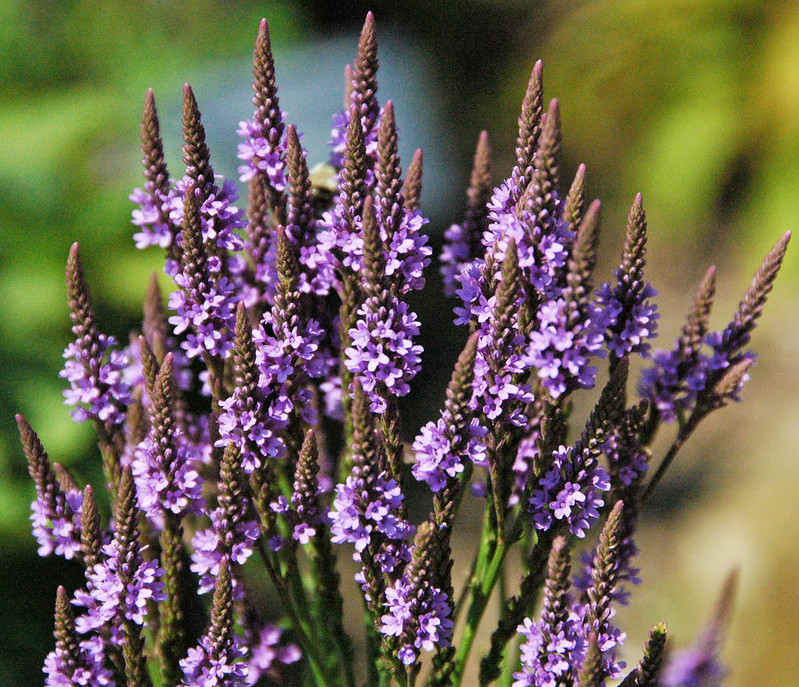
Photo Credit: James St. John / Flickr / CC BY 2.0
Verbena hastata is also known as swamp verbena or American vervain and is found all over the U.S. Blue vervain features a hairy, stiff, straight stem that grows as tall as 5 feet and features flowering spikes of violet, deep purple, or (rarely) white blooms. Trust this plant to add texture and structure to your Missouri landscape with its upright stems and groups of bluish-purple flowers blooming from early summer to early fall.
Its densely packed flowers are used by herbalists and may also be incorporated into bath and body products such as foot creams and soaks. Blue vervain attracts butterflies, bumblebees, and birds of all sorts. It prefers well-drained soils and performs best when paired with full, bright sun.
Plant type: Flower
Mature size: 4 to 5 feet tall
Duration: Perennial
Bloom time: May to September
Sunlight needs: Full sun or partial shade
Soil preferences: Moist or wet
Water needs: High
Maintenance needs: Low
USDA hardiness zone: 3 to 9
4. White Beardtongue (Penstemon digitalis)
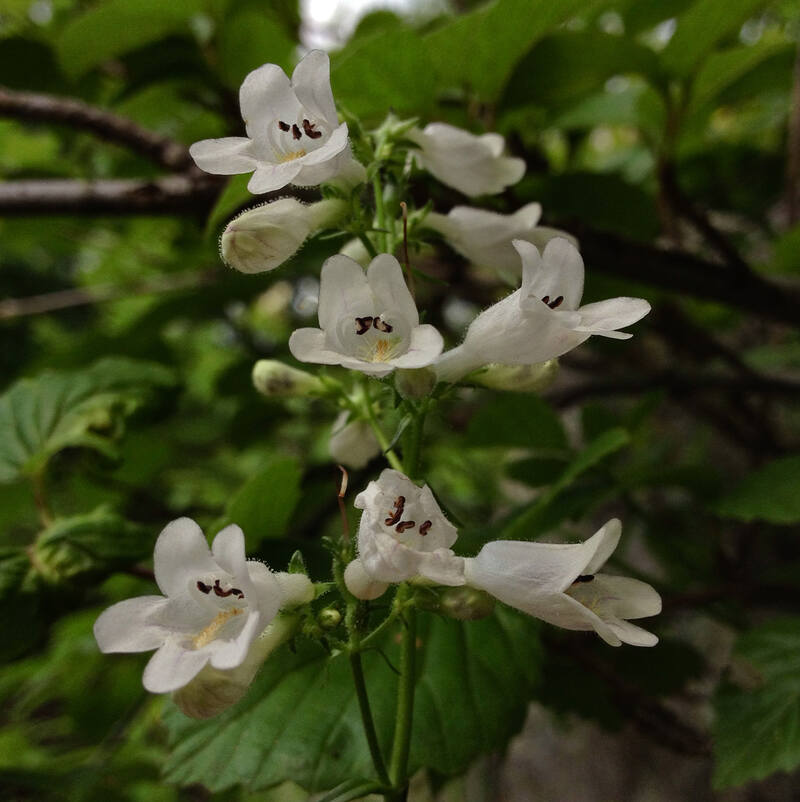
Photo Credit: Fritzflohrreynolds / Wikimedia Commons / CC BY-SA 3.0
Also known as foxglove beardtongue or talus slope penstemon, this Missouri native occurs naturally in open woods, fields, meadows, and prairies, or any place that has sandy and moist soils. A perennial, the white beardtongue forms tubular clusters of showy white flowers that attract hummingbirds and butterflies.
One of the many advantages of inviting white beardtongue into your yard is that it won’t have any serious diseases or pest issues. This plant prefers well-drained soil but is super easy to grow and maintain otherwise.
Plant type: Herbaceous
Mature size: 4 to 5 feet tall
Duration: Perennial
Bloom time: April to July
Sunlight needs: Full sun
Soil preferences: Moist, loamy
Water needs: Low
Maintenance needs: Low
USDA hardiness zone: 3 to 8
5. Pawpaw (Asimina Triloba)
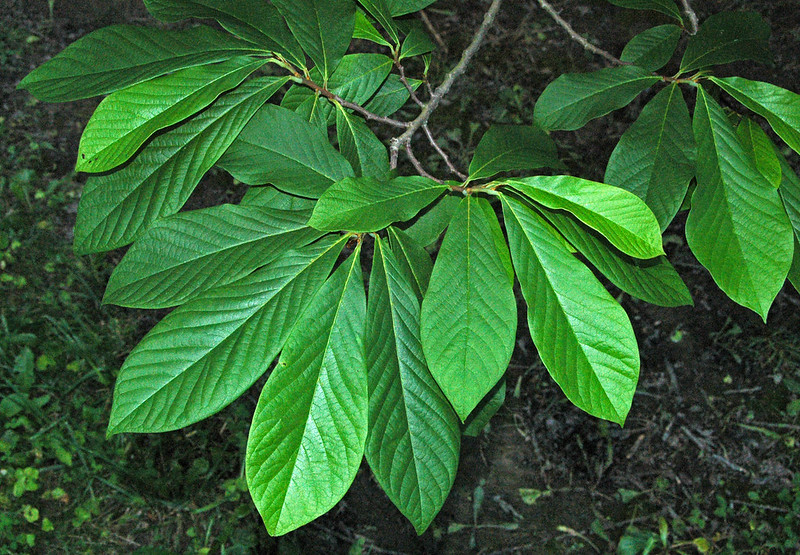
Photo Credit: James St. John / Flickr / CC BY 2.0
Asimina Triloba is a small tree, though it looks more like a shrub due to its short-heightened trunk, that grows 10 to 40 feet tall. It features large, tropical-like leaves that turn from green to a beautiful yellow-green in fall and sprout purple flowers. When it has matured, pawpaw grows cylindric, yellow, or dark-green edible fruit.
The deciduous pawpaw fruit has a banana-like taste and is typically consumed raw or used in pies and ice creams. It attracts wildlife but does not attract serious insect or disease problems.
Plant type: Tree
Mature size: 4 to 5 feet tall
Duration: Perennial
Bloom time: April to May
Sunlight needs: Full sun to part shade
Soil preferences: Medium to wet, well-drained soil
Water needs: Medium
Maintenance needs: Low
USDA hardiness zone: 5 to 9
6. Wild Hydrangea (Hydrangea arborescens)
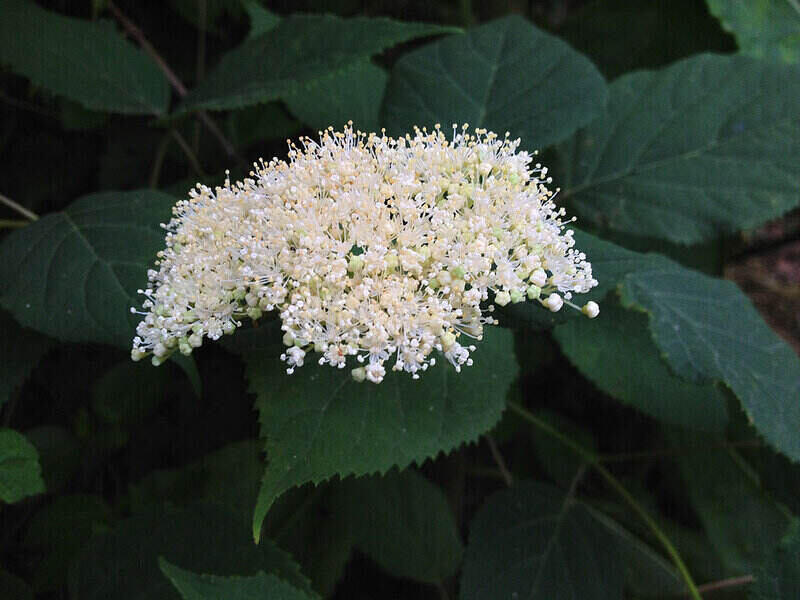
Photo Credit: Fritzflohrreynolds / Wikimedia Commons / CC BY-SA 3.0
This widely branched deciduous flowering shrub is native to rocky wooded slopes, moist stream banks, and ravines. Wild hydrangea features broad egg-like round, dark green leaves with pale undersides, and sharp teeth all around. These leaves turn fully yellow in the fall.
It bursts with clusters of tiny white flowers, but a few large sterile flowers may appear around the cluster margins. Hydrangea can grow in almost any type of soil but prefer to stay moderately moist at all times. It can be a good choice for a rain garden in Missouri owing to its high tolerance for wet soils.
On the down side, wild hydrangea is susceptible to several insect and disease problems such as bacterial wilt, leaf spots, powdery mildew, and aphids.
Plant type: Flowering plant
Mature size: 3 to 5 feet tall
Duration: Perennial
Bloom time: June to September
Sunlight needs: Partial shade
Soil preferences: Clay, shallow, rocky
Water needs: Medium
Maintenance needs: Moderate to high
USDA hardiness zone: 3 to 9
7. Flowering Dogwood (Cornus florida)
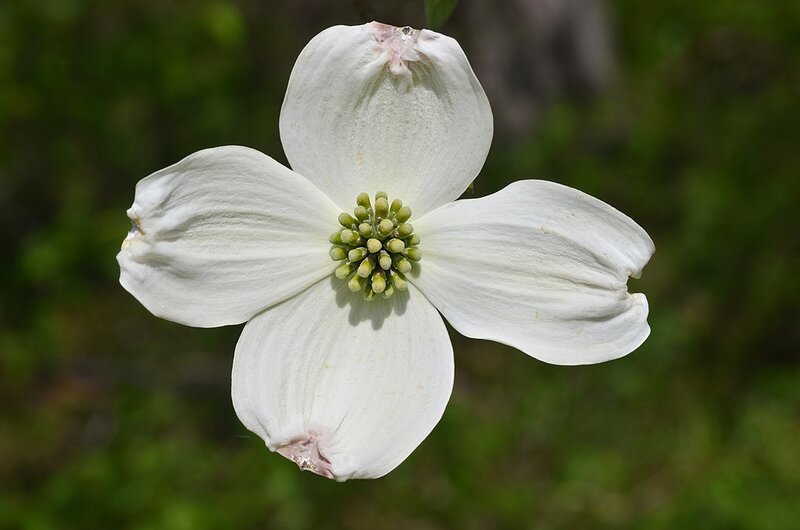
Photo Credit: Derek Ramsey (Ram-Man) / Wikimedia Commons / CC BY-SA 4.0
This is a popular tree found throughout the Eastern United States. It produces beautiful white blooms around April and May and develops bright red fruits in the late summer. Flowering dogwood’s green tree leaves turn into rust and then go through multiple hues of red in the fall.
The good part is, this dogwood tree is not a high-maintenance native. In fact, it prefers partial shade to grow. However, you might want to take care of diseases because flowering dogwood can develop diseases like powdery mildew, dogwood anthracnose, root rot, and more when it’s stressed.
Plant type: Tree
Mature size: 15 to 30 feet tall
Duration: Perennial
Bloom time: April to June
Sunlight needs: Full sun or partial shade, prefers partial shade
Soil preferences: Well-drained, acidic, and average soil with lots of organic matter
Water needs: Medium
Maintenance needs: Medium
USDA hardiness zone: 3 to 9
8. Blazing Star (Liatris spicata)
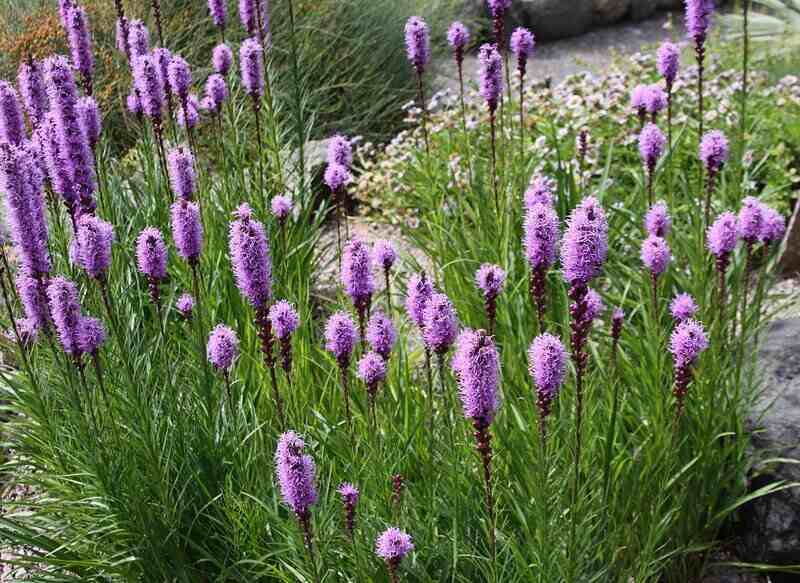
Photo Credit: Drew Avery / Wikimedia Commons / CC BY 2.0
Prairie blazing star is a low-maintenance flower that provides a nice pop of color in your garden. It produces tall, leafy stalks that develop spikes of rounded, fluffy, deep purple flower heads. Blazing star grows best in well-drained soils with a full sun but does fine in poor soils as well. It is highly tolerant of humidity and summer heat and is a generally low-maintenance plant.
Plant type: Flower
Mature size: 2 to 5 feet tall
Duration: Perennial
Bloom time: July to August
Sunlight needs: Full sun
Soil preferences: Well-drained, average soil
Water needs: Medium, prefers dry or moderately moist soil
Maintenance needs: Low
USDA hardiness zone: 3 to 9
9. Spicebush (Lindera benzoin)
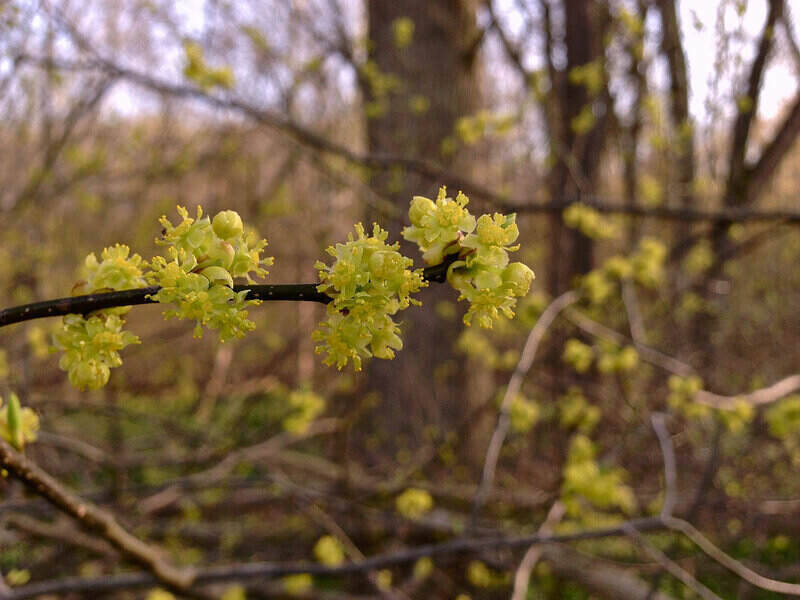
Photo Credit: Fritzflohrreynolds / Wikimedia Commons / CC BY-SA 3.0
This deciduous shrub can grow as tall as 15 feet and have a unique aroma to it. Spicebush shrub develops a brown or gray-brown bark with light-colored lenticels speckled around. It produces clusters of small, yellow flowers in early spring and smooth-margined leaves. These leaves are crushed to extract the spicy odor they produce.
Spicebush is tolerant of deer and heavy shade. The lightly scented flora will also attract colorful birds and butterflies to your Missouri lawn. But this plant is sensitive to drought and heat. Male varieties of these plants develop relatively larger greenish-yellow flowers whereas the female spicebush may also produce a small red fruit with a male pollinator.
Plant type: Shrub
Mature size: 6 to 15 feet tall
Duration: Perennial
Bloom time: February to March
Sunlight needs: Full sun to partial shade
Soil preferences: Loam or sandy soils, limestone-based
Water needs: Medium
Maintenance needs:
USDA hardiness zone: 5 to 9
10. Purple Coneflower (Echinacea purpurea)
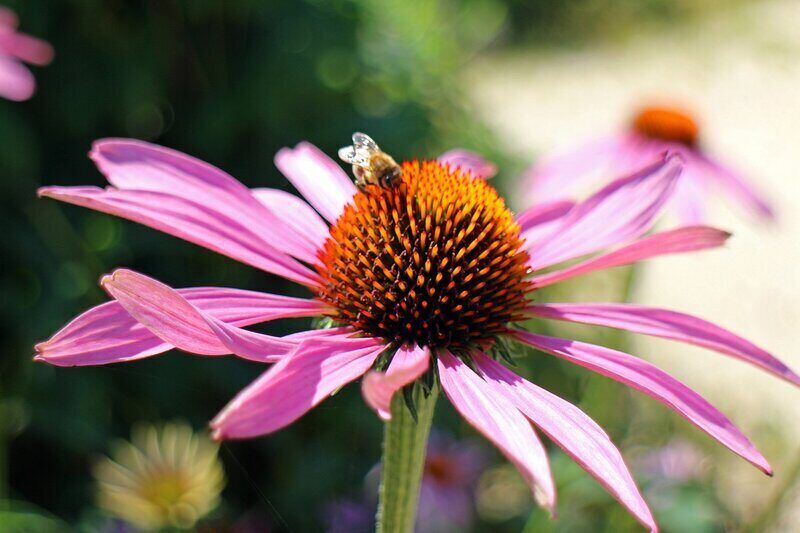
Photo Credit: Pixabay
Echinacea purpurea is a herbaceous perennial from the Asteraceae family and is one of the toughest Missouri native plants. It’s super easy to grow and maintain. Purple coneflower can power through several challenging environments, be it drought, humidity, heat, or poor soil conditions.
Apart from its impressive adaptability, this plant may also make a popular spot for hummingbirds and insects. It typically grows up to 5 feet tall and produces daisy-like, showy flowers that bloom throughout the summer months. It also bears coarse, dark green foliage around a stiff stem that remains erect well into the winter.
Plant type: Flower
Mature size: 2 to 5 feet tall
Duration: Perennial
Bloom time: June to August
Sunlight needs: Full sun to partial shade, but prefers full sun
Soil preferences: Well-drained soils
Water needs: Medium to low
Maintenance needs: Low
USDA hardiness zone: 3 to 8
11. Blue Lobelia (Lobelia siphilitica)
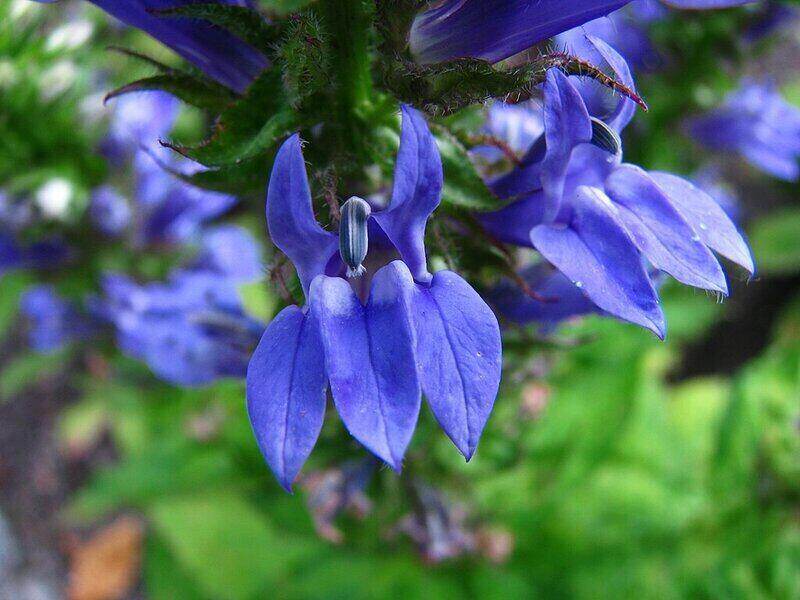
Photo Credit: Agnieszka Kwiecień / Wikimedia Commons / CC BY-SA 3.0
Blue lobelia resembles cardinal flowers and is commonly known as a blue cardinal flower as well. It makes a great choice for rain gardens and is good if you wish to attract butterflies, bees, and hummingbirds to your yards. This herbaceous perennial gives blue flowers that bloom from mid-summer all through early fall. These blue flowers have striped tubes and are accompanied by leaves with toothed margins.
It’s extremely hardy, pest-free, and fairly a low-care plant. You can count on blue lobelia to not become invasive despite being a self-seeding plant.
Plant type: Flower
Mature size: 2 to 4 feet tall
Duration: Perennial
Bloom time: September to October
Sunlight needs: Full sun to partial shade
Soil preferences: Clay, loam, sand
Water needs: High to medium
Maintenance needs: Low
USDA hardiness zone: 4 to 9
12. Swamp Milkweed (Asclepias incarnata)
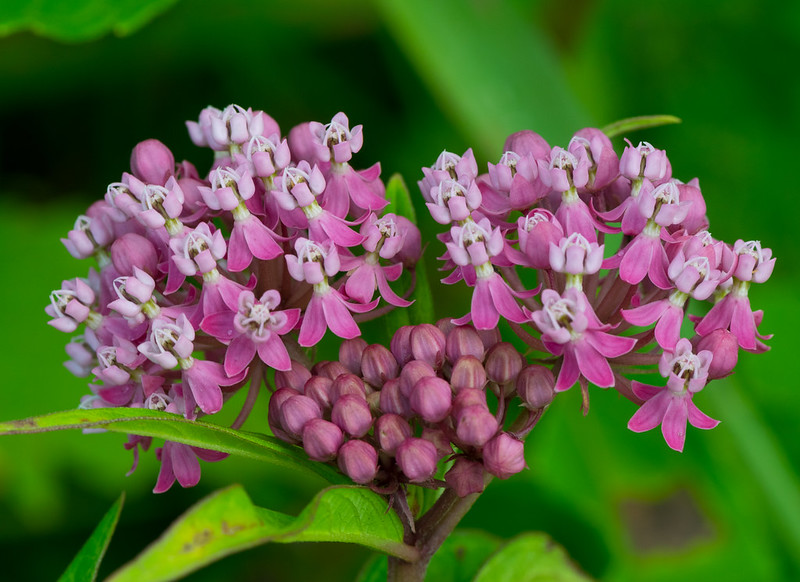
Photo Credit: Joshua Mayer / Flickr / CC BY-SA 2.0
This moisture-loving perennial grows up to 5 feet tall in sunny openings of swamps, bogs, marshes, fens, and along stream banks. It has an erect stem with narrow, lance-shaped, and sharp-tipped leaves. Swamp milkweed develops fragrant clusters of flowers in pink, mauve, or reddish-violet color.
Swamp milkweed flowers attract hummingbirds and butterflies from all around. It’s also an important source of food for monarch caterpillars. However, it also invites a variety of insects, that aren’t a problem unless the plant shows signs of sickness.
Plant type: Flower
Mature size: 2 to 5 feet tall
Duration: Perennial
Bloom time: July to August
Sunlight needs: Sun or partial shade
Soil preferences: Moist
Water needs: High
Maintenance needs:
USDA hardiness zone: 3 to 9
13. Butterfly Milkweed (Asclepias tuberosa)
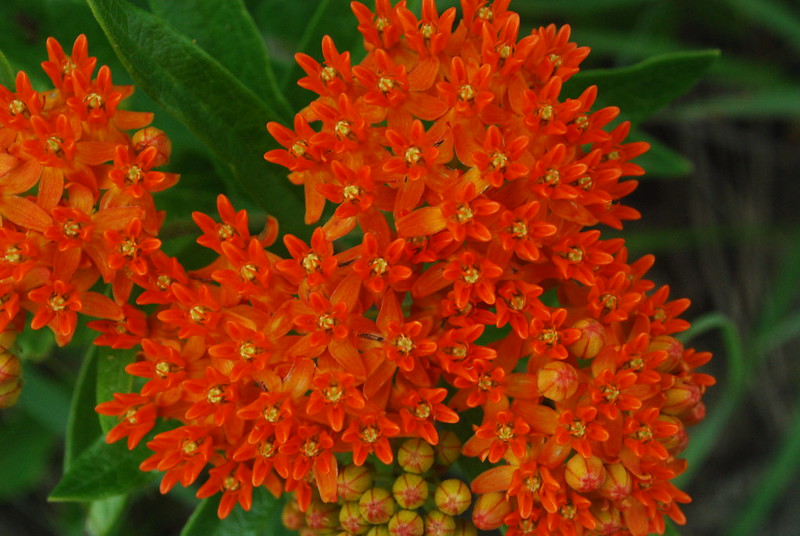
Photo Credit: Joshua Mayer / Flickr / CC BY-SA 2.0
This is another low-maintenance native plant that will fill your Missouri garden with a lovely color from early to mid-summer. It’s a tuberous rooted plant that occurs mostly in dry or rocky open woods, prairies, glades, roadsides, and fields. Butterfly milkweed develops clusters of yellow-orange or bright-orange flowers that sit atop hairy stems. The stems are clad with narrow, lance-shaped leaves.
These flowers serve as a source of nectar for butterflies and its leaves are a popular food source for monarch butterfly larvae. Butterfly milkweed is also drought tolerant and well-performing in dry or poor soils.
Plant type: Flower
Mature size: 1 to 2.5 feet tall
Duration: Perennial
Bloom time: June to August
Sunlight needs: Full sun
Soil preferences: Well-drained soil
Water needs: Medium
Maintenance needs: Low
USDA hardiness zone: 3 to 9
14. Pink Turtlehead (Chelone lyonii)
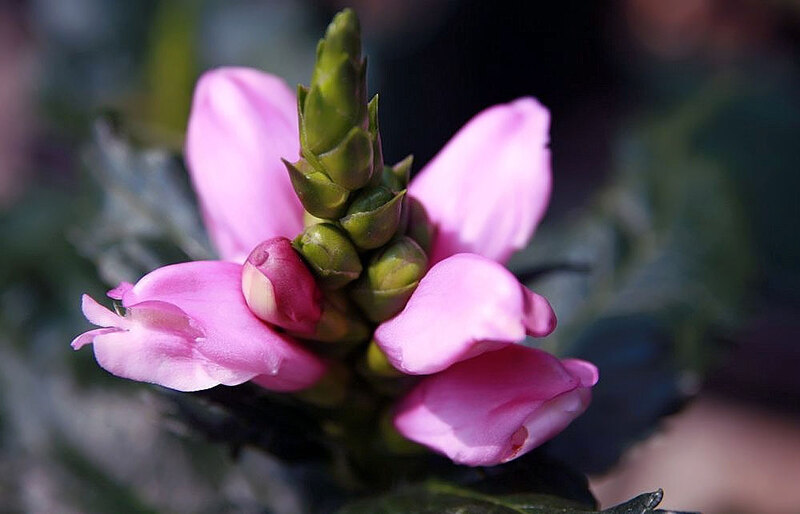
Photo Credit: David J. Stang / Wikimedia Commons / CC BY-SA 4.0
This tall Missouri wildflower is also known as “Rose Turtlehead.” It blooms between late summer and early fall. It produces bright pink hooded flowers that rest on top of stiff, square stems. Pink turtlehead flowers look like the heads of open-mouthed turtles and get their name from this very resemblance.
It best grows in medium to wet soils with full sun to part shade, but can also do okay in part shade areas. Although resistant to disease and insects, pink turtlehead shows some susceptibility to mildew, especially if the soil is dry or has poor air circulation.
Plant type: Wildflower
Mature size: 1.5 to 6.5 feet tall
Duration: Perennial
Bloom time: Late July to September
Sunlight needs: Full sun or partial shade
Soil preferences: Moist, rich, clay, loamy, sandy
Water needs: High
Maintenance needs: Medium
USDA hardiness zone: 3 to 8
15. Red Buckeye (Aesculus pavia)
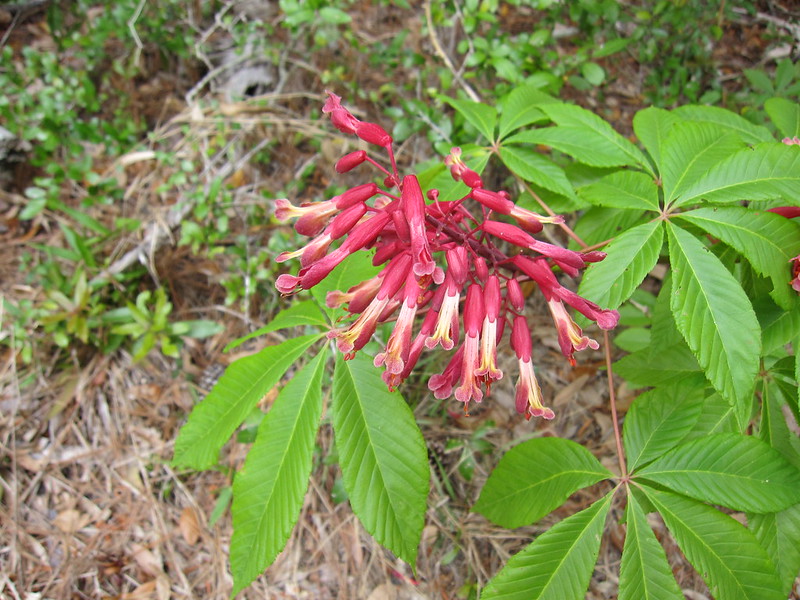
Photo Credit: Chris M Morris / Flickr / CC BY 2.0
Red buckeye is a clump-forming deciduous shrub that creates an irregular crown and bears erect, showy panicles of orange-red to red, tubular flowers. These flowers bloom in spring and begin to decline late in the season along with its dark green, shiny leaves.
This plant also produces light-brown, globular seed capsules that encase 1 to 3 shiny but poisonous seeds. These seeds ripen in the fall and are avoided by wildlife. Red buckeye flowers, however, attract hummingbirds.
Plant type: Deciduous shrub
Mature size: 12 to 15 feet tall
Duration: Perennial
Bloom time: April to May
Sunlight needs: Full sun to partial shade
Soil preferences: Medium-moisture, well-drained soil
Water needs: Medium
Maintenance needs: Medium
USDA hardiness zone: 4 to 8
16. Prairie Dropseed (Sporobolus heterolepis)
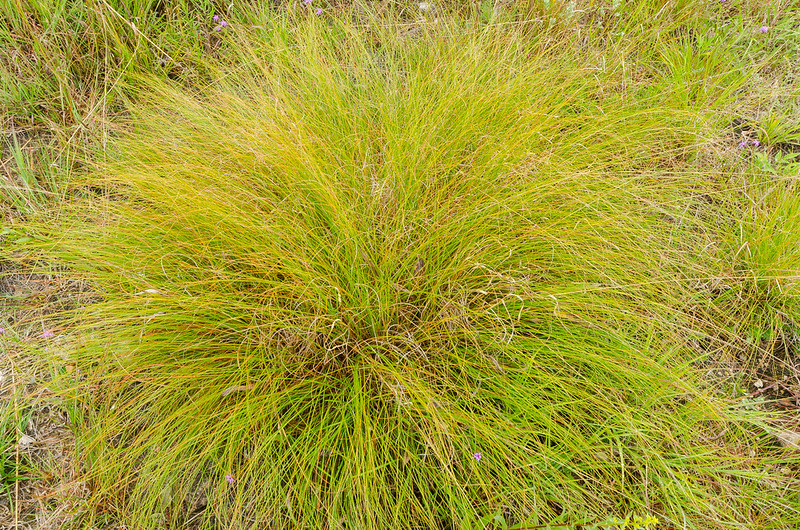
Photo Credit: Joshua Mayer / Flickr / CC BY-SA 2.0
Sporobolus hereolepis is favored by many homeowners and landscapers for its decorative appearance. It is a fine-textured ornamental grass with long, arching leaves that form beautiful round tufts. From rich green hues in summer to shades of golden and orange, this Missouri native grass stays pretty late into the fall.
Prairie dropseed has resilient foliage that powers through snow and extremely low temperatures. It’s a slow-growing grass but isn’t fussy about soil type and growing conditions.
Plant type: Grass
Mature size: 2 to 3 feet tall
Duration: Perennial
Bloom time: June to August
Sunlight needs: Full sun
Soil preferences: Rocky, sandy, clay
Water needs: Low
Maintenance needs: Low
USDA hardiness zone: 3 to 9
Choosing the Best Natives for Your Missouri Landscape
Picking native plants does not always turn out to be a win-win situation. The key is to select the right natives that will naturally perform well with the light, soil, and wind exposure in your locality.
To do that, make sure you take into account the plant’s USDA Hardiness Zone range. This range essentially helps in determining the most suitable native plants for your Missouri yard. Missouri Hardiness Zone is 5b through 7a.
The Final Word
And when your new native plants have made their way to your home, it’s time to create a final look with some landscaping around the other parts of your garden. You can take a few ideas from Wikilawn’s page to pick the best grass types and low-maintenance plants for your Missouri landscape.
If you feel like it’s a little too much to manage, call in one of our pros to handle all the planning, planting, and maintenance work for you.
Main Photo by: Lydia Fravel / Flickr / CC BY 2.0